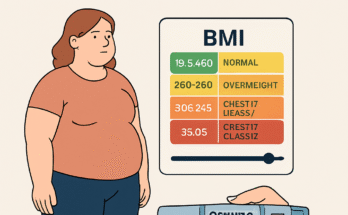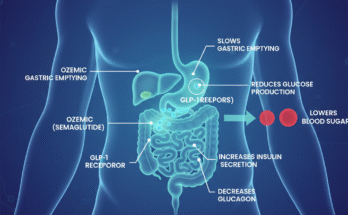As a weight loss specialist researching Ozempic, I often get asked how long this medication lingers in the body after a dose. It’s a fair question—when considering a drug like Ozempic, whether for managing type 2 diabetes or aiding weight loss, understanding its pharmacokinetics (how it moves through your system) is crucial. Ozempic, known generically as semaglutide, is a powerful GLP-1 receptor agonist that has transformed treatment plans for many of my patients. Its long-lasting effects are part of its appeal, but they also raise practical concerns about how long it stays active, what happens when you stop taking it, and how it impacts your body over time. In this guide, I’ll walk you through the science behind Ozempic’s duration in the system, its implications for treatment, and what you need to know to make informed decisions. My goal is to provide clear, evidence-based answers, drawing from the latest research and my own experience working with patients.
What Is Ozempic and Why Does Its Duration Matter?
Ozempic is a once-weekly injectable medication primarily approved by the FDA for managing type 2 diabetes. Its active ingredient, semaglutide, mimics a hormone called glucagon-like peptide-1 (GLP-1), which regulates blood sugar, slows digestion, and reduces appetite. These effects make it effective not only for diabetes but also for weight loss, as seen in clinical trials like the STEP programme, where patients lost an average of 14.9% of their body weight over 68 weeks. The FDA also approved a higher-dose version of semaglutide, marketed as Wegovy, specifically for chronic weight management in 2021.
Understanding how long Ozempic stays in your system is important for several reasons. If you’re starting or stopping the drug, you need to know how long its effects persist. If you’re planning surgery or other medications, its presence in your body could influence medical decisions. And if you’re using it for weight loss, you might wonder how long it takes to clear out if you experience side effects or decide to discontinue. Let’s dive into the science to answer these questions.
The Half-Life of Ozempic: The Key to Its Duration
The time a drug stays in your system is often measured by its half-life—the time it takes for half of the drug to be eliminated from your bloodstream. For Ozempic, the half-life is approximately one week (about 7 days), which is why it’s designed for weekly injections. This long half-life is due to semaglutide’s molecular structure, which allows it to bind to albumin, a protein in your blood, slowing its breakdown and extending its activity.
In practical terms, after a single dose of Ozempic, it takes about 5 to 6 half-lives (roughly 5 to 6 weeks) for the drug to be nearly fully eliminated from your body. This means that if you take a 0.5 mg dose on Monday, trace amounts could still be present in your system more than a month later. However, the therapeutic effects—such as appetite suppression and blood sugar control—typically wane much sooner, often within 1 to 2 weeks after your last dose, depending on your dosage and individual metabolism.
What Happens When You Stop Taking Ozempic?
One question I hear often is, “What happens when I stop taking Ozempic?” This is especially relevant for those using it for weight loss, as many worry about regaining weight. When you stop Ozempic, its levels in your blood gradually decline over several weeks due to its long half-life. You might notice the effects—less appetite suppression, faster gastric emptying, or changes in blood sugar control—fading within 1 to 2 weeks after your last dose.
Factors That Affect How Long Ozempic Stays in Your System
Not everyone processes Ozempic at the same rate. Several factors can influence how long it stays in your system:
- Dosage: Ozempic is typically prescribed at 0.25 mg, 0.5 mg, 1 mg, or 2 mg weekly. Higher doses result in higher concentrations in your blood, which may take slightly longer to clear.
- Body composition: Your weight, body fat, and metabolism can affect how your body handles Ozempic. In my research, I’ve noted that patients with higher body mass sometimes report slightly prolonged effects.
- Kidney and liver function: While Ozempic is primarily cleared through metabolic pathways rather than the kidneys or liver, impaired organ function can subtly alter its clearance. Always discuss your medical history with your doctor.
- Consistency of dosing: If you’ve been taking Ozempic for weeks or months, the drug accumulates steadily, meaning it may take longer to fully clear compared to a single dose.
Practical Implications for Patients
Knowing how long Ozempic stays in your system has real-world implications. Here are some scenarios I often discuss with my patients:
- Starting Ozempic: It takes about 4 to 5 weeks for Ozempic to reach its full effect. I advise patients to be patient during this ramp-up period and to start with a low dose (0.25 mg) to minimise side effects like nausea.
- Missing a dose: If you miss a dose, you can take it within 5 days without disrupting the drug’s steady state. Beyond that, I recommend skipping the dose and resuming your schedule, as the drug’s long half-life ensures some residual effect.
- Stopping Ozempic: If you’re planning to stop, discuss a tapering plan with your doctor. Abruptly stopping can lead to rapid changes in appetite or blood sugar, which can be jarring.
- Surgery or other medications: Ozempic slows gastric emptying, which may increase the risk of aspiration during surgery. The FDA recommends stopping Ozempic at least one week before procedures requiring anesthesia.
Side Effects and Their Duration
Side effects are a common concern for my patients starting Ozempic. The most frequent ones—nausea, vomiting, and diarrhoea—tend to peak early in treatment and often subside within a few weeks as your body adjusts. Because of Ozempic’s long half-life, these side effects may persist for 1 to 2 weeks after your last dose, especially if you were on a higher dose.
More serious but rare side effects, like pancreatitis or gallbladder issues, require immediate medical attention. In my experience, patients who follow a gradual dose increase (starting at 0.25 mg and moving up slowly) are less likely to experience severe side effects. If you’re struggling with side effects, I encourage you to talk to your doctor about adjusting your dose or exploring supportive measures like dietary changes.
Integrating Ozempic with Lifestyle Changes
While Ozempic is a powerful tool, it’s not a magic bullet. In my practice, I’ve seen the best results when patients combine Ozempic with lifestyle changes. A balanced diet rich in vegetables, lean proteins, and whole grains enhances Ozempic’s appetite-suppressing effects. Regular exercise—aim for 150 minutes of moderate activity per week—helps maintain weight loss and improves overall health. I also recommend working with a dietitian or therapist to address emotional eating, as Ozempic won’t tackle the psychological aspects of weight management on its own.
When you stop Ozempic, these lifestyle habits become even more critical. Without the drug’s appetite control, you may feel hungrier, and weight regain is a risk. I’ve worked with patients who successfully maintained their weight loss by sticking to a structured plan post-Ozempic, but it takes commitment.
What Does the Future Hold for Ozempic?
As a researcher, I’m excited about the ongoing studies exploring semaglutide’s long-term effects. Trials are investigating its role in preventing cardiovascular disease, managing obesity-related conditions, and even treating non-alcoholic fatty liver disease. New GLP-1 agonists are also in development, potentially offering similar benefits with fewer side effects or lower costs. For now, Ozempic remains a cornerstone of treatment, but I encourage patients to stay informed about emerging options.
Frequently Asked Questions
How can I flush Ozempic out of my system?
No, there is no way to expedite the removal of Ozempic from your system. The medication is naturally processed and eliminated through urine and stool over several weeks.
How long does Ozempic keep working after you stop taking it?
Ozempic is a long-lasting medication with a half-life of 1 week. It can take up to 5 weeks for the drug to leave your system. If you stop taking Ozempic, you may experience an increase in your blood sugar or regain lost weight. It may also lead to other effects.
What happens if you stop taking Ozempic suddenly?
When you stop taking Ozempic, you may notice some immediate effects, like an increase in appetite or blood sugar levels. Most people will gain back most of the weight that they lost while taking Ozempic. But some research shows that you may still get heart-health benefits even after stopping Ozempic.
Is Ozempic hard on the body?
Ozempic has side effects related to the digestive tract, such as diarrhea, constipation, and vomiting. Less common or severe side effects may include hiccups, dry mouth, an inflamed pancreas, and low blood sugar. Drinking plenty of fluids and temporarily limiting your diet to certain foods can relieve common side effects.
What is the biggest side effect of Ozempic?
The most common side effects of Ozempic may include:
Nausea. Diarrhea
Stomach (abdominal) pain. Vomiting.
Constipation.
Conclusion
Ozempic is a remarkable medication that has helped many of my patients manage diabetes and achieve significant weight loss. Its long half-life of about one week means it stays in your system for roughly 5 to 6 weeks after your last dose, with effects like appetite suppression fading sooner. Understanding this timeline can help you plan your treatment, manage side effects, and prepare for what happens if you stop. My advice? Work closely with your healthcare provider to tailor Ozempic to your needs, combine it with healthy lifestyle changes, and stay proactive about monitoring your progress. If you’re considering Ozempic, take the first step by discussing it with your doctor to see if it’s right for you.

Emily Harper is a board-certified nurse practitioner and certified obesity medicine specialist with a strong clinical background in metabolic health and GLP-1 therapies. With years of frontline experience managing patients on Ozempic, she brings both scientific knowledge and real-world insight to her writing.




